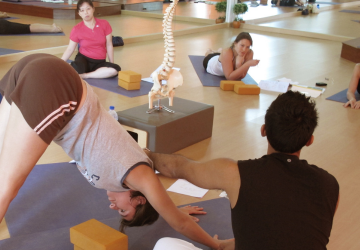Yoga Anatomy Course: Explore the Body-Mind Connection in Yoga
in Teacher TrainingWhat you will learn?
Develop a foundational understanding of human anatomy, including bones, muscles, joints, and organs.
Explore the structure and function of cells, the building blocks of the human body.
Gain insights into the body's organization and in-depth knowledge of the 11 organ systems.
Understand the interrelation between yoga practices and their impact on each system of the body.
Recognize the significance of proper body mechanics and their influence on overall health.
Identify common injuries, conditions, and the benefits of incorporating yoga into a wellness routine.
About this course
Join our 30-hour Anatomy, Physiology, and Biomechanics module, consisting of 10 hours of expert-led classroom or virtual learning with Dr. Abhishek Agrawal and 20 hours of self-study through interactive slides, videos, and PDF materials.
This comprehensive module is specifically designed for yoga teachers, equipping them with the knowledge of the human body, joint movement, muscle actions, and stretching awareness, as well as an understanding of physical limitations. Enhance your teaching skills to provide safe, effective, and personalized instruction tailored to the needs of your students or clients.
The anatomy module empowers you to determine when further study is required or when it's appropriate to refer students to other specialized teachers. In short, this course is inarguably the best Yoga Anatomy and Physiology Course online.
Requirements
Enrolled or Completed Yoga Teacher Training in any style.
Comments (0)
This chapter covers the structure and function of cells, body organization, and the roles of the 11 organ systems in our body.
The chapter introduces the integumentary, skeletal, muscular, and nervous systems collectively known as the structural systems. Gain knowledge about individual bones and joints, their locations, and available movements.
The chapter covers the anatomy & functions of the circulatory, respiratory, digestive, and urinary systems collectively known as the organ systems. You will learn how to recognize the organs that are linked to the organelle systems of the body and understand functions and the effects on other systems of the body.
The chapter covers the anatomy & functions of the Endocrine, immune, and digestive systems collectively known as the glandular system. You will learn how to recognize the organs that are linked to the glandular system of the body and understand the functions and interrelation with the other system of the body.
Femur (thighs), Tibia + Fibula (lower legs), Calcaneus (heels), Metatarsal (mid-foot arches), Phalyngeal (toes)
The quadriceps group of muscles are located on the front of the thigh. They consist of four distinct muscles: the rectus femoris, the vastus lateralis, the vastus intermedius, and the vastus medialis.
The adductors group of muscles are located on the inner thigh. They consists of adductor longus, adductor brevis, adductor magnus, and gracillis.
The gluteal group of muscles forms the buttocks. Thery consists of the gluteus maximus, gluteus medius, and gluteus minimus.
The hamstring group of muscles are located on the back of the thigh. They consist of the biceps femoris, semitendinosus and semimembranosus.
Located on the back of the leg, the calf muscle consists of gastrocnemius and soleus.
Scapula (shoulder blade), Humerus (upper arm), Redius + Ulna (forearm bone), Metacarpal (palms), Phalyngeal (fingers)
The Deltoid muscle is a large triangular-shaped muscle covering the shoulder joint giving the shoulder its rounded contour. Its comprised of three parts Anterior, Middle and Lateral.
The Pectoral muscle is a large triangular-shaped muscle making up the chest area. It is comprised of two parts Pectoralis minor (deep) and Pectoralis major (superficial).
The trapezius muscle is a large superficial back muscle that resembles a trapezoid. It is comprised of the Upper, Middle and Lower trapezius.
The Biceps muscle is located in the front portion of the upper arm.
The Triceps muscle is located in the back portion of the upper arm.
Quiz & Certificates






